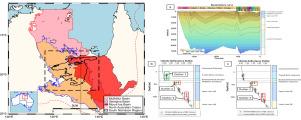Quantifying the basin dynamics of the Proterozoic Carrara Sub-basin to understand the assembly and evolution of the Australian continent
IF 7.2
1区 地球科学
Q1 GEOSCIENCES, MULTIDISCIPLINARY
引用次数: 0
Abstract
Formed around the time of the Nuna supercontinent, the South Nicholson region is part of a resource-abundant region in Australia and is also a rich source of sedimentary information about the development of the Australian continent and associated supercontinents, from Nuna to Rodinia and Gondwana. In this paper, we analyse the recently acquired data across the Carrara Sub-basin in the central South Nicholson region, which includes five seismic lines (17GA-SN) and a new well (NDI Carrara 1). The analysis of the data utilises decompaction and backstripping techniques to assess tectonic subsidence and calculate maximum burial depths. These results are calibrated using vitrinite reflectance data to quantify the erosional history of the basin. As a result, we identified five phases of subsidence and four erosional events within the South Nicholson region during the Proterozoic and Paleozoic periods. The Proterozoic formations reached a maximum burial depth of up to 7500 m, which concluded with the Isan Orogeny 1.6 Ga, likely initiating an uplift and erosional event during the collision of Laurentia and Australia. Our results indicate that 2600 m of erosion occurred from this event to 540 Ma. In the Early Cambrian, from 540 Ma to 500 Ma, significant subsidence occurred again, with the newly formed Neoproterozoic sediments reaching a maximum burial depth of 2000 m. This subsidence event was concurrent with the extension related to the breakup of Rodinia. Subsequently, from the Late Ordovician to the Early Cretaceous, we calculate that 600 m of erosion occurred, concurrent with the Alice Springs Orogeny. This erosional surface is overlain by only 6 m of Cenozoic sediment cover. Our results quantify the sedimentary history of the South Nicholson region and connect its evolution to the tectonic processes shaping Australia since 1.6 Ga. These results provide insights into the broader supercontinental cycles of Nuna, Rodinia, and Gondwana.

量化元古代卡拉拉亚盆地的盆地动力学,了解澳大利亚大陆的组合与演化
南尼科尔森地区形成于努纳超大陆时期,是澳大利亚资源丰富地区的一部分,也是澳大利亚大陆及其相关超大陆(从努纳到罗迪尼亚和冈瓦纳)发育的沉积信息的丰富来源。本文分析了南Nicholson地区中部Carrara次盆地最近获得的数据,包括5条地震线(17GA-SN)和1口新井(NDI Carrara 1)。数据分析利用分解和反剥离技术来评估构造沉降并计算最大埋藏深度。这些结果使用镜质组反射率数据进行校准,以量化盆地的侵蚀历史。结果表明,南尼克尔森地区在元古宙和古生代经历了5期沉降和4次侵蚀事件。元古代地层的最大埋藏深度可达7500 m,结束于伊桑造山运动~ 1.6 Ga,可能在Laurentia和澳大利亚碰撞期间开始了隆起和侵蚀事件。我们的结果表明,从这次事件到540 Ma,发生了~ 2600 m的侵蚀。早寒武世540 ~ 500 Ma,再次发生明显的沉降,新形成的新元古代沉积物最大埋藏深度达到2000 m。该下沉事件与Rodinia分裂相关的伸展同时发生。随后,从晚奥陶世到早白垩世,我们计算出与爱丽斯泉造山运动同时发生了~ 600 m的侵蚀。这一侵蚀面上仅覆盖约6米的新生代沉积物覆盖物。我们的结果量化了南尼科尔森地区的沉积历史,并将其演化与1.6 Ga以来塑造澳大利亚的构造过程联系起来。这些结果为更广泛的努纳、罗迪尼亚和冈瓦纳超大陆旋回提供了见解。
本文章由计算机程序翻译,如有差异,请以英文原文为准。
求助全文
约1分钟内获得全文
求助全文
来源期刊

Gondwana Research
地学-地球科学综合
CiteScore
12.90
自引率
6.60%
发文量
298
审稿时长
65 days
期刊介绍:
Gondwana Research (GR) is an International Journal aimed to promote high quality research publications on all topics related to solid Earth, particularly with reference to the origin and evolution of continents, continental assemblies and their resources. GR is an "all earth science" journal with no restrictions on geological time, terrane or theme and covers a wide spectrum of topics in geosciences such as geology, geomorphology, palaeontology, structure, petrology, geochemistry, stable isotopes, geochronology, economic geology, exploration geology, engineering geology, geophysics, and environmental geology among other themes, and provides an appropriate forum to integrate studies from different disciplines and different terrains. In addition to regular articles and thematic issues, the journal invites high profile state-of-the-art reviews on thrust area topics for its column, ''GR FOCUS''. Focus articles include short biographies and photographs of the authors. Short articles (within ten printed pages) for rapid publication reporting important discoveries or innovative models of global interest will be considered under the category ''GR LETTERS''.
 求助内容:
求助内容: 应助结果提醒方式:
应助结果提醒方式:


